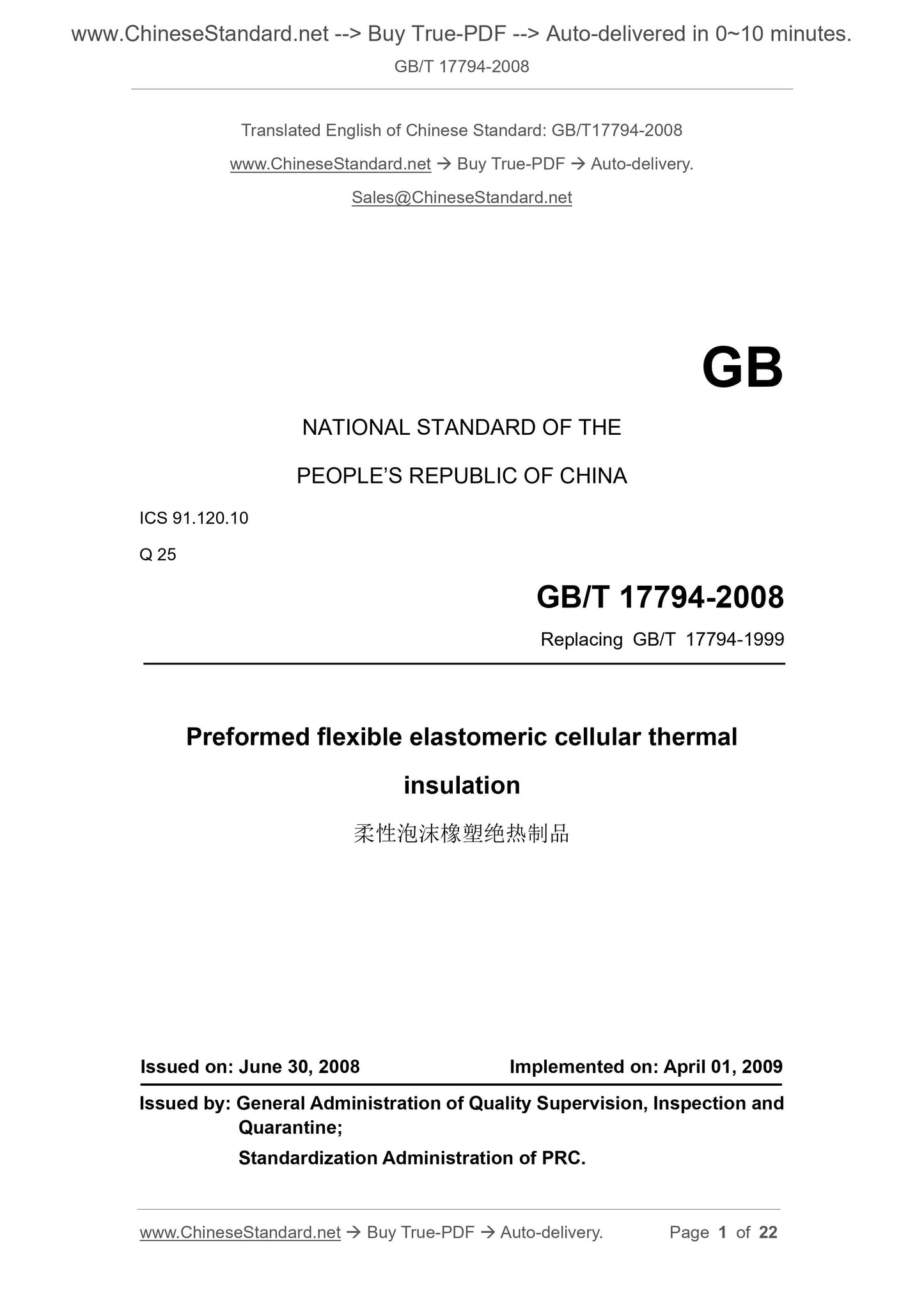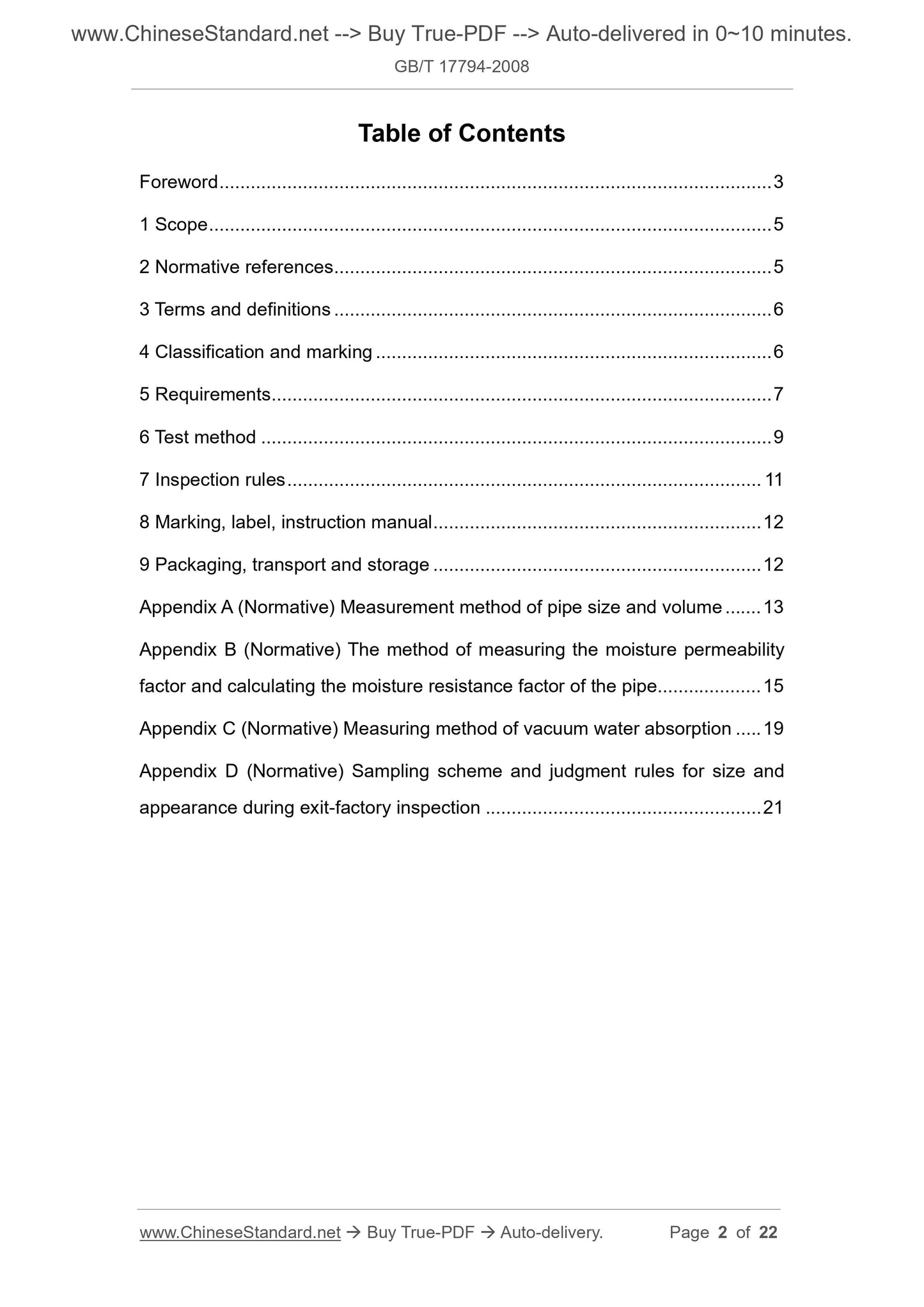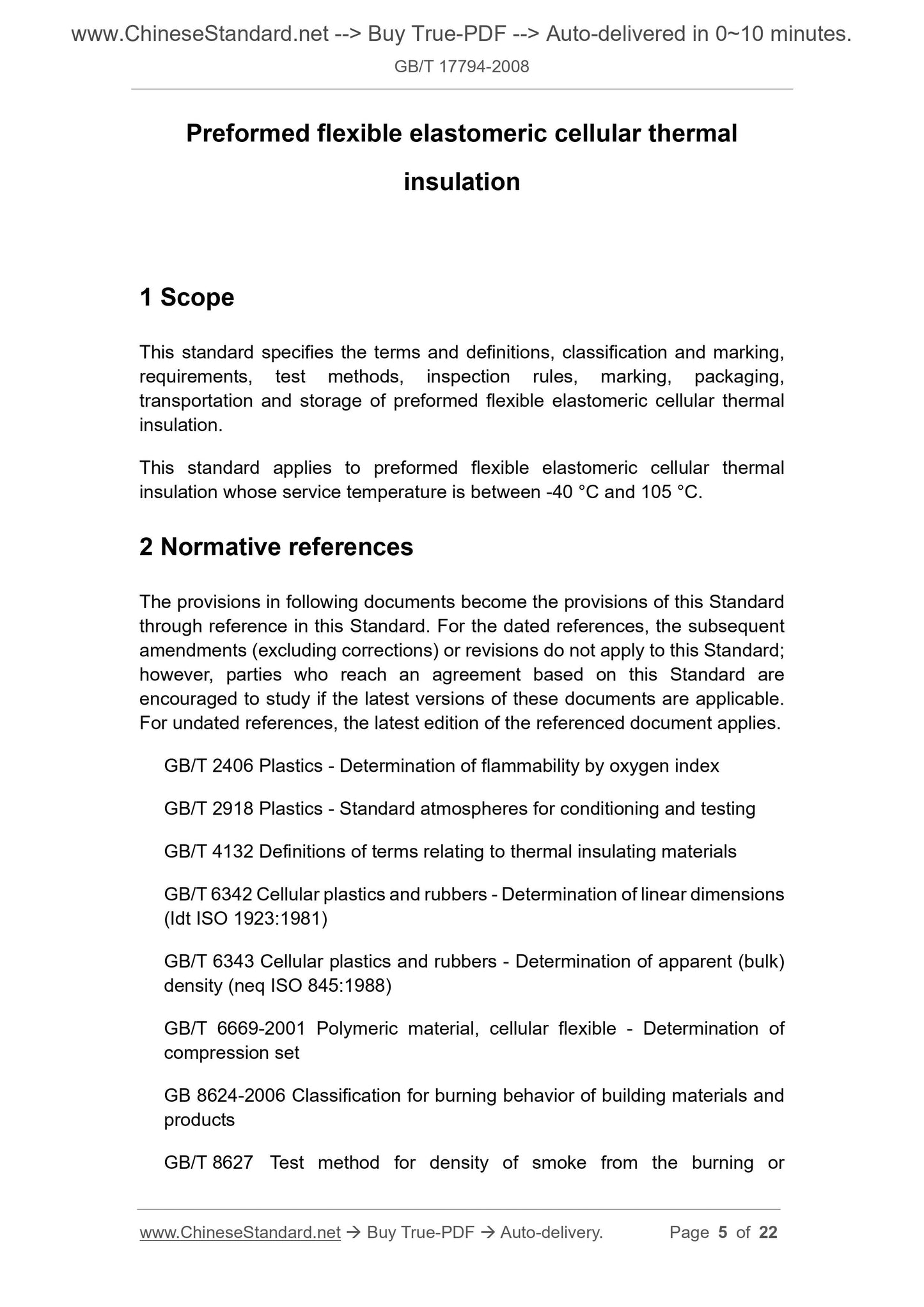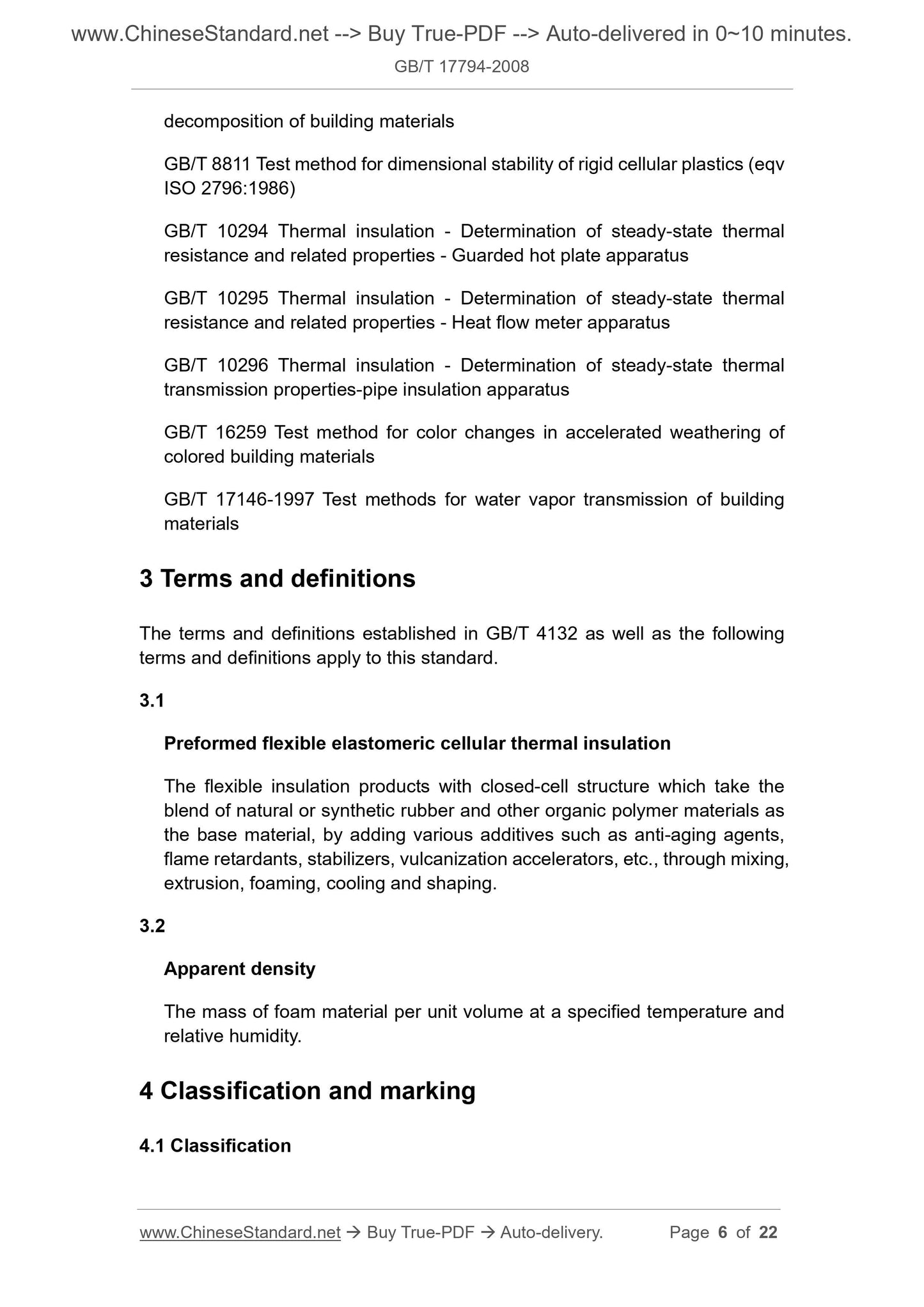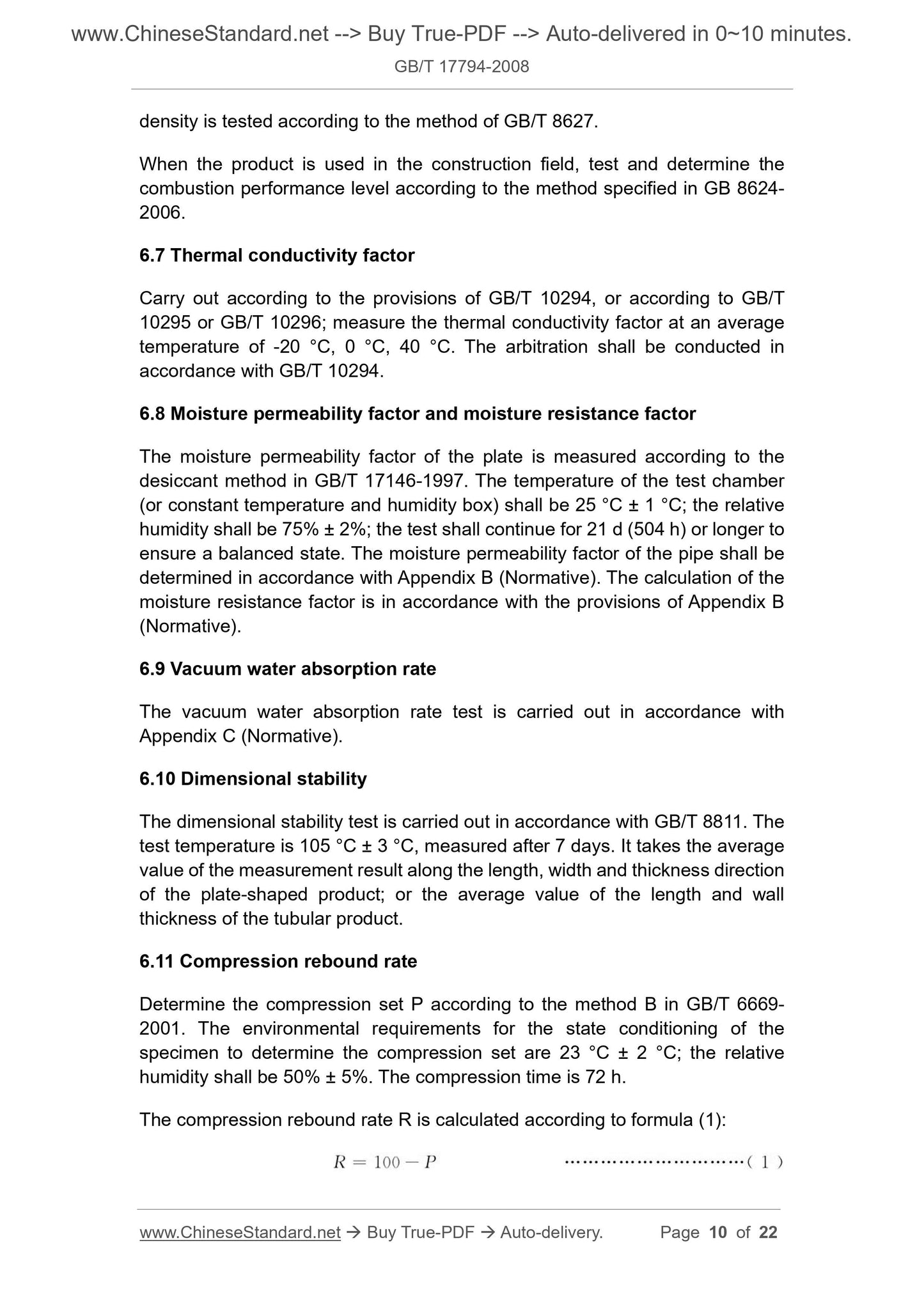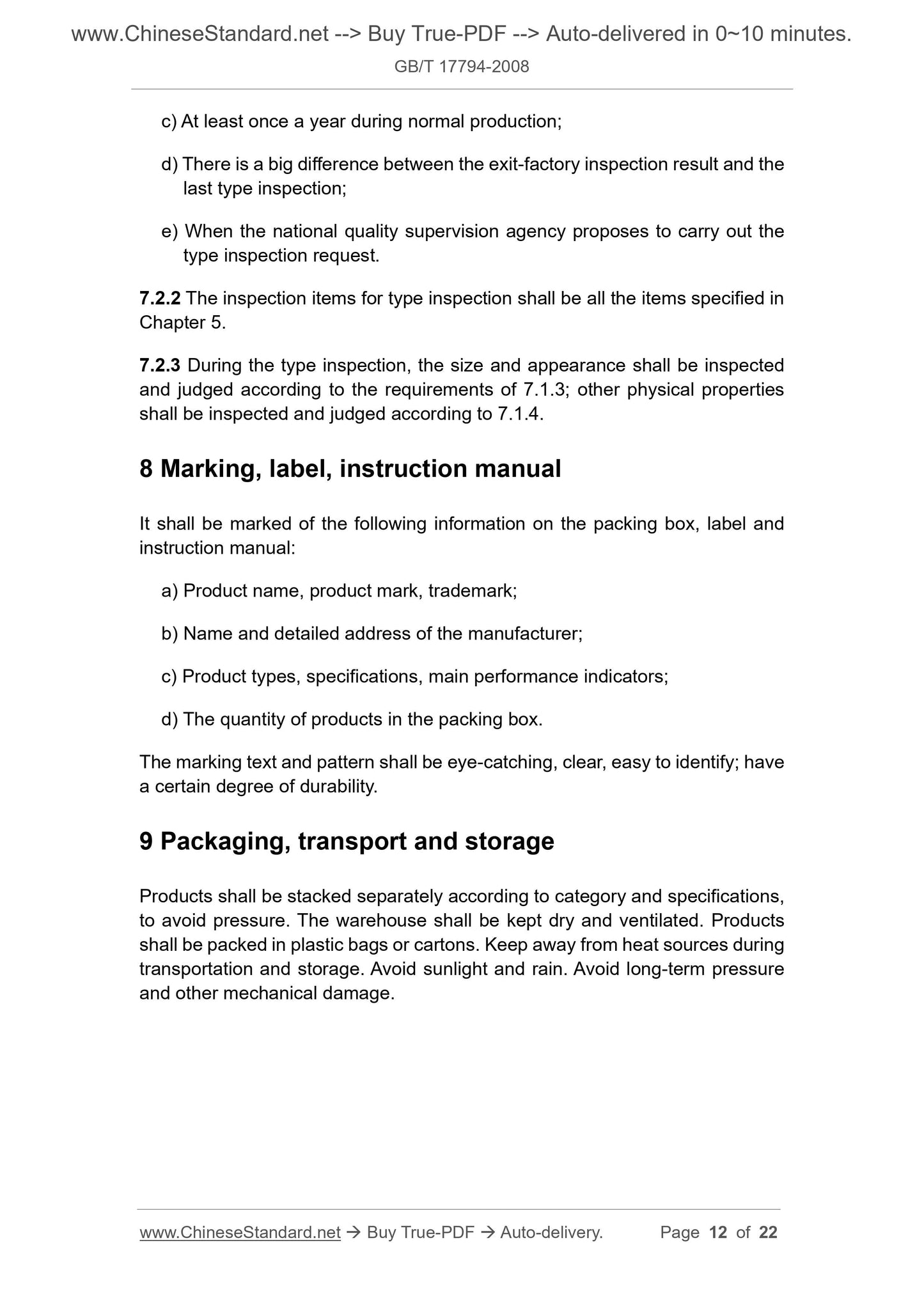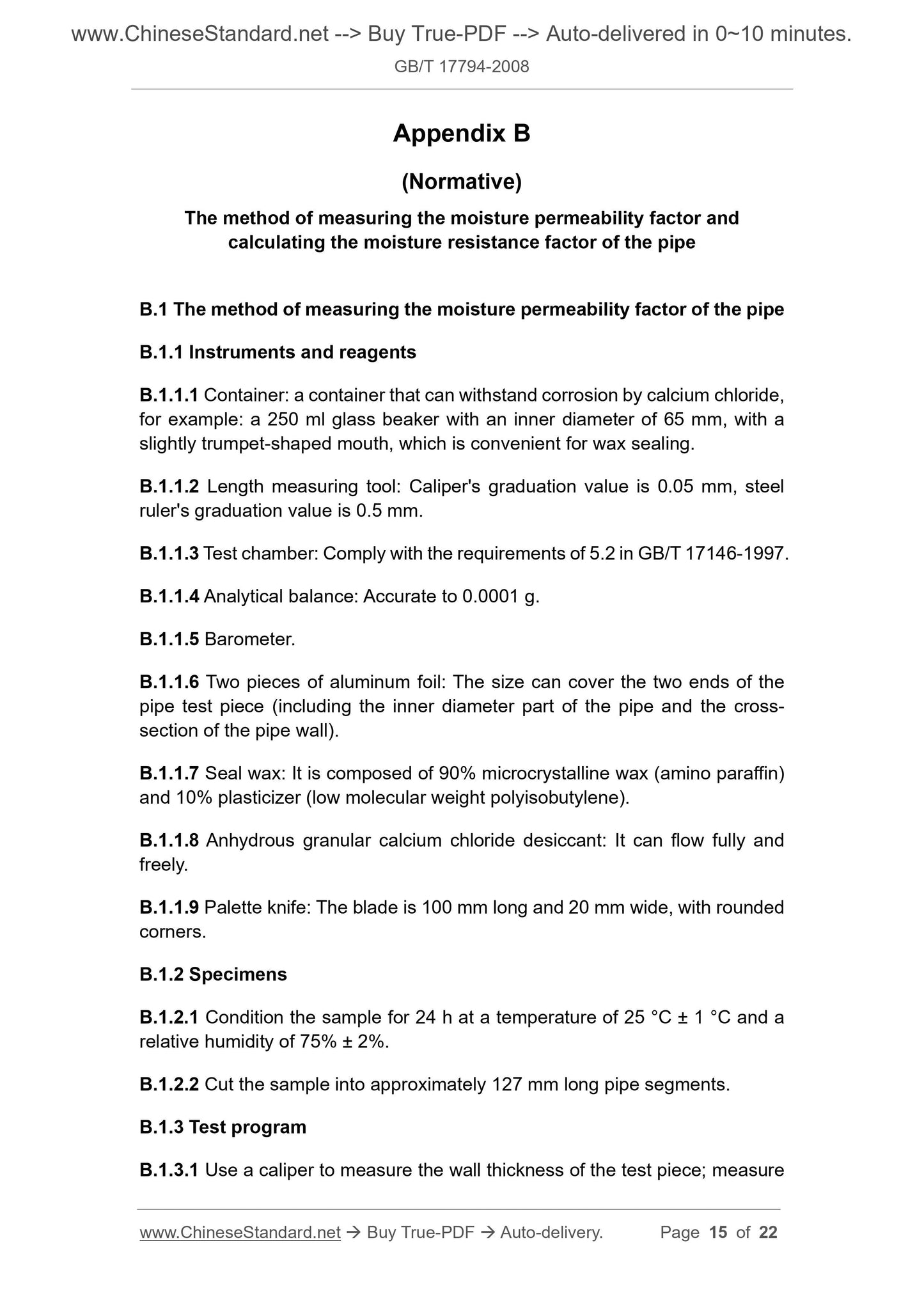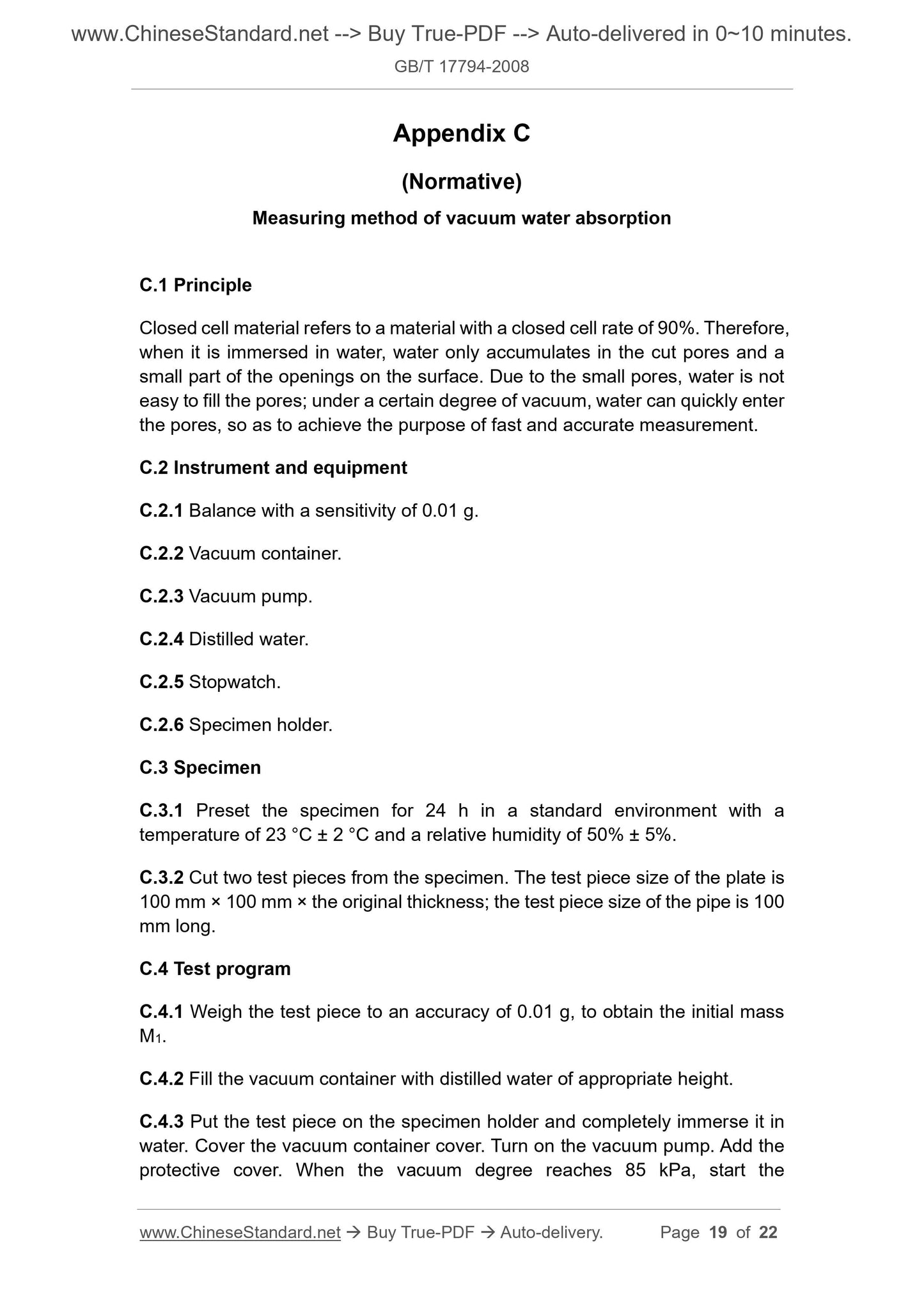1
/
of
8
PayPal, credit cards. Download editable-PDF and invoice in 1 second!
GB/T 17794-2008 English PDF (GBT17794-2008)
GB/T 17794-2008 English PDF (GBT17794-2008)
Regular price
$105.00 USD
Regular price
Sale price
$105.00 USD
Unit price
/
per
Shipping calculated at checkout.
Couldn't load pickup availability
Delivery: 3 seconds. Download true-PDF + Invoice.Newer version: (Replacing this standard) GB/T 17794-2021
Get QUOTATION in 1-minute: Click GB/T 17794-2008
Historical versions: GB/T 17794-2008
Preview True-PDF (Reload/Scroll if blank)
GB/T 17794-2008: Preformed flexible elastomeric cellular thermal insulation
GB/T 17794-2008
GB
NATIONAL STANDARD OF THE
PEOPLE’S REPUBLIC OF CHINA
ICS 91.120.10
Q 25
Replacing GB/T 17794-1999
Preformed flexible elastomeric cellular thermal
insulation
柔性泡沫橡塑绝热制品
ISSUED ON: JUNE 30, 2008
IMPLEMENTED ON: APRIL 01, 2009
Issued by: General Administration of Quality Supervision, Inspection and
Quarantine;
Standardization Administration of PRC.
Table of Contents
Foreword ... 3
1 Scope ... 5
2 Normative references ... 5
3 Terms and definitions ... 6
4 Classification and marking ... 6
5 Requirements ... 7
6 Test method ... 9
7 Inspection rules ... 11
8 Marking, label, instruction manual ... 12
9 Packaging, transport and storage ... 12
Appendix A (Normative) Measurement method of pipe size and volume ... 13
Appendix B (Normative) The method of measuring the moisture permeability
factor and calculating the moisture resistance factor of the pipe... 15
Appendix C (Normative) Measuring method of vacuum water absorption ... 19
Appendix D (Normative) Sampling scheme and judgment rules for size and
appearance during exit-factory inspection ... 21
Preformed flexible elastomeric cellular thermal
insulation
1 Scope
This standard specifies the terms and definitions, classification and marking,
requirements, test methods, inspection rules, marking, packaging,
transportation and storage of preformed flexible elastomeric cellular thermal
insulation.
This standard applies to preformed flexible elastomeric cellular thermal
insulation whose service temperature is between -40 °C and 105 °C.
2 Normative references
The provisions in following documents become the provisions of this Standard
through reference in this Standard. For the dated references, the subsequent
amendments (excluding corrections) or revisions do not apply to this Standard;
however, parties who reach an agreement based on this Standard are
encouraged to study if the latest versions of these documents are applicable.
For undated references, the latest edition of the referenced document applies.
GB/T 2406 Plastics - Determination of flammability by oxygen index
GB/T 2918 Plastics - Standard atmospheres for conditioning and testing
GB/T 4132 Definitions of terms relating to thermal insulating materials
GB/T 6342 Cellular plastics and rubbers - Determination of linear dimensions
(Idt ISO 1923:1981)
GB/T 6343 Cellular plastics and rubbers - Determination of apparent (bulk)
density (neq ISO 845:1988)
GB/T 6669-2001 Polymeric material, cellular flexible - Determination of
compression set
GB 8624-2006 Classification for burning behavior of building materials and
products
GB/T 8627 Test method for density of smoke from the burning or
decomposition of building materials
GB/T 8811 Test method for dimensional stability of rigid cellular plastics (eqv
ISO 2796:1986)
GB/T 10294 Thermal insulation - Determination of steady-state thermal
resistance and related properties - Guarded hot plate apparatus
GB/T 10295 Thermal insulation - Determination of steady-state thermal
resistance and related properties - Heat flow meter apparatus
GB/T 10296 Thermal insulation - Determination of steady-state thermal
transmission properties-pipe insulation apparatus
GB/T 16259 Test method for color changes in accelerated weathering of
colored building materials
GB/T 17146-1997 Test methods for water vapor transmission of building
materials
3 Terms and definitions
The terms and definitions established in GB/T 4132 as well as the following
terms and definitions apply to this standard.
3.1
Preformed flexible elastomeric cellular thermal insulation
The flexible insulation products with closed-cell structure which take the
blend of natural or synthetic rubber and other organic polymer materials as
the base material, by adding various additives such as anti-aging agents,
flame retardants, stabilizers, vulcanization accelerators, etc., through mixing,
extrusion, foaming, cooling and shaping.
3.2
Apparent density
The mass of foam material per unit volume at a specified temperature and
relative humidity.
4 Classification and marking
4.1 Classification
density is tested according to the method of GB/T 8627.
When the product is used in the construction field, test and determine the
combustion performance level according to the method specified in GB 8624-
2006.
6.7 Thermal conductivity factor
Carry out according to the provisions of GB/T 10294, or according to GB/T
10295 or GB/T 10296; measure the thermal conductivity factor at an average
temperature of -20 °C, 0 °C, 40 °C. The arbitration shall be conducted in
accordance with GB/T 10294.
6.8 Moisture permeability factor and moisture resistance factor
The moisture permeability factor of the plate is measured according to the
desiccant method in GB/T 17146-1997. The temperature of the test chamber
(or constant temperature and humidity box) shall be 25 °C ± 1 °C; the relative
humidity shall be 75% ± 2%; the test shall continue for 21 d (504 h) or longer to
ensure a balanced state. The moisture permeability factor of the pipe shall be
determined in accordance with Appendix B (Normative). The calculation of the
moisture resistance factor is in accordance with the provisions of Appendix B
(Normative).
6.9 Vacuum water absorption rate
The vacuum water absorption rate test is carried out in accordance with
Appendix C (Normative).
6.10 Dimensional stability
The dimensional stability test is carried out in accordance with GB/T 8811. The
test temperature is 105 °C ± 3 °C, measured after 7 days. It takes the average
value of the measurement result along the length, width and thickness direction
of the plate-shaped product; or the average value of the length and wall
thickness of the tubular product.
6.11 Compression rebound rate
Determine the compression set P according to the method B in GB/T 6669-
2001. The environmental requirements for the state conditioning of the
specimen to determine the compression set are 23 °C ± 2 °C; the relative
humidity shall be 50% ± 5%. The compression time is 72 h.
The compression rebound rate R is calculated according to formula (1):
c) At least once a year during normal production;
d) There is a big difference between the exit-factory inspection result and the
last type inspection;
e) When the national quality supervision agency proposes to carry out the
type inspection request.
7.2.2 The inspection items for type inspection shall be all the items specified in
Chapter 5.
7.2.3 During the type inspection, the size and appearance shall be inspected
and judged according to the requirements of 7.1.3; other physical properties
shall be inspected and judged according to 7.1.4.
8 Marking, label, instruction manual
It shall be marked of the following information on the packing box, label and
instruction manual:
a) Product name, product mark, trademark;
b) Name and detailed address of the manufacturer;
c) Product types, specifications, main performance indicators;
d) The quantity of products in the packing box.
The marking text and pattern shall be eye-catching, clear, easy to identify; have
a certain degree of durability.
9 Packaging, transport and storage
Products shall be stacked separately according to category and specifications,
to avoid pressure. The warehouse shall be kept dry and ventilated. Products
shall be packed in plastic bags or...
Get QUOTATION in 1-minute: Click GB/T 17794-2008
Historical versions: GB/T 17794-2008
Preview True-PDF (Reload/Scroll if blank)
GB/T 17794-2008: Preformed flexible elastomeric cellular thermal insulation
GB/T 17794-2008
GB
NATIONAL STANDARD OF THE
PEOPLE’S REPUBLIC OF CHINA
ICS 91.120.10
Q 25
Replacing GB/T 17794-1999
Preformed flexible elastomeric cellular thermal
insulation
柔性泡沫橡塑绝热制品
ISSUED ON: JUNE 30, 2008
IMPLEMENTED ON: APRIL 01, 2009
Issued by: General Administration of Quality Supervision, Inspection and
Quarantine;
Standardization Administration of PRC.
Table of Contents
Foreword ... 3
1 Scope ... 5
2 Normative references ... 5
3 Terms and definitions ... 6
4 Classification and marking ... 6
5 Requirements ... 7
6 Test method ... 9
7 Inspection rules ... 11
8 Marking, label, instruction manual ... 12
9 Packaging, transport and storage ... 12
Appendix A (Normative) Measurement method of pipe size and volume ... 13
Appendix B (Normative) The method of measuring the moisture permeability
factor and calculating the moisture resistance factor of the pipe... 15
Appendix C (Normative) Measuring method of vacuum water absorption ... 19
Appendix D (Normative) Sampling scheme and judgment rules for size and
appearance during exit-factory inspection ... 21
Preformed flexible elastomeric cellular thermal
insulation
1 Scope
This standard specifies the terms and definitions, classification and marking,
requirements, test methods, inspection rules, marking, packaging,
transportation and storage of preformed flexible elastomeric cellular thermal
insulation.
This standard applies to preformed flexible elastomeric cellular thermal
insulation whose service temperature is between -40 °C and 105 °C.
2 Normative references
The provisions in following documents become the provisions of this Standard
through reference in this Standard. For the dated references, the subsequent
amendments (excluding corrections) or revisions do not apply to this Standard;
however, parties who reach an agreement based on this Standard are
encouraged to study if the latest versions of these documents are applicable.
For undated references, the latest edition of the referenced document applies.
GB/T 2406 Plastics - Determination of flammability by oxygen index
GB/T 2918 Plastics - Standard atmospheres for conditioning and testing
GB/T 4132 Definitions of terms relating to thermal insulating materials
GB/T 6342 Cellular plastics and rubbers - Determination of linear dimensions
(Idt ISO 1923:1981)
GB/T 6343 Cellular plastics and rubbers - Determination of apparent (bulk)
density (neq ISO 845:1988)
GB/T 6669-2001 Polymeric material, cellular flexible - Determination of
compression set
GB 8624-2006 Classification for burning behavior of building materials and
products
GB/T 8627 Test method for density of smoke from the burning or
decomposition of building materials
GB/T 8811 Test method for dimensional stability of rigid cellular plastics (eqv
ISO 2796:1986)
GB/T 10294 Thermal insulation - Determination of steady-state thermal
resistance and related properties - Guarded hot plate apparatus
GB/T 10295 Thermal insulation - Determination of steady-state thermal
resistance and related properties - Heat flow meter apparatus
GB/T 10296 Thermal insulation - Determination of steady-state thermal
transmission properties-pipe insulation apparatus
GB/T 16259 Test method for color changes in accelerated weathering of
colored building materials
GB/T 17146-1997 Test methods for water vapor transmission of building
materials
3 Terms and definitions
The terms and definitions established in GB/T 4132 as well as the following
terms and definitions apply to this standard.
3.1
Preformed flexible elastomeric cellular thermal insulation
The flexible insulation products with closed-cell structure which take the
blend of natural or synthetic rubber and other organic polymer materials as
the base material, by adding various additives such as anti-aging agents,
flame retardants, stabilizers, vulcanization accelerators, etc., through mixing,
extrusion, foaming, cooling and shaping.
3.2
Apparent density
The mass of foam material per unit volume at a specified temperature and
relative humidity.
4 Classification and marking
4.1 Classification
density is tested according to the method of GB/T 8627.
When the product is used in the construction field, test and determine the
combustion performance level according to the method specified in GB 8624-
2006.
6.7 Thermal conductivity factor
Carry out according to the provisions of GB/T 10294, or according to GB/T
10295 or GB/T 10296; measure the thermal conductivity factor at an average
temperature of -20 °C, 0 °C, 40 °C. The arbitration shall be conducted in
accordance with GB/T 10294.
6.8 Moisture permeability factor and moisture resistance factor
The moisture permeability factor of the plate is measured according to the
desiccant method in GB/T 17146-1997. The temperature of the test chamber
(or constant temperature and humidity box) shall be 25 °C ± 1 °C; the relative
humidity shall be 75% ± 2%; the test shall continue for 21 d (504 h) or longer to
ensure a balanced state. The moisture permeability factor of the pipe shall be
determined in accordance with Appendix B (Normative). The calculation of the
moisture resistance factor is in accordance with the provisions of Appendix B
(Normative).
6.9 Vacuum water absorption rate
The vacuum water absorption rate test is carried out in accordance with
Appendix C (Normative).
6.10 Dimensional stability
The dimensional stability test is carried out in accordance with GB/T 8811. The
test temperature is 105 °C ± 3 °C, measured after 7 days. It takes the average
value of the measurement result along the length, width and thickness direction
of the plate-shaped product; or the average value of the length and wall
thickness of the tubular product.
6.11 Compression rebound rate
Determine the compression set P according to the method B in GB/T 6669-
2001. The environmental requirements for the state conditioning of the
specimen to determine the compression set are 23 °C ± 2 °C; the relative
humidity shall be 50% ± 5%. The compression time is 72 h.
The compression rebound rate R is calculated according to formula (1):
c) At least once a year during normal production;
d) There is a big difference between the exit-factory inspection result and the
last type inspection;
e) When the national quality supervision agency proposes to carry out the
type inspection request.
7.2.2 The inspection items for type inspection shall be all the items specified in
Chapter 5.
7.2.3 During the type inspection, the size and appearance shall be inspected
and judged according to the requirements of 7.1.3; other physical properties
shall be inspected and judged according to 7.1.4.
8 Marking, label, instruction manual
It shall be marked of the following information on the packing box, label and
instruction manual:
a) Product name, product mark, trademark;
b) Name and detailed address of the manufacturer;
c) Product types, specifications, main performance indicators;
d) The quantity of products in the packing box.
The marking text and pattern shall be eye-catching, clear, easy to identify; have
a certain degree of durability.
9 Packaging, transport and storage
Products shall be stacked separately according to category and specifications,
to avoid pressure. The warehouse shall be kept dry and ventilated. Products
shall be packed in plastic bags or...
Share
